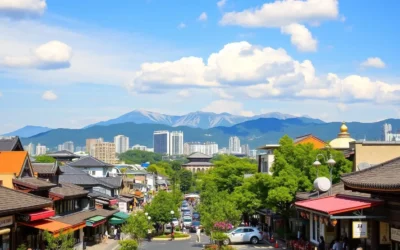✓ Accommodations✓ Flights✓ Rental Cars
You are about to explore the rich cultural landscape of a region known for its distinctive dialects and historical significance. The Korean language has a fascinating history that spans thousands of years, with its roots tracing back to the Stone Age.
As you delve into the world of language and culture, you’ll uncover how the linguistic heritage of this region reflects its unique identity within the broader context of Korean civilization. The evolution of the Korean language has been shaped by various kingdoms and dynasties that once ruled the peninsula.
You’ll gain insights into the language used in everyday communication and its significance as a cultural artifact that preserves local traditions and values.
The Linguistic Landscape of South Korea
South Korea’s linguistic landscape is a fascinating reflection of its history, culture, and people. At the heart of this landscape is the Korean language, which serves as the official language throughout the country.
The Korean language is a unique and integral part of the country’s identity, with its own distinct grammar, vocabulary, and alphabet known as Hangul. Created in the 15th century by King Sejong the Great, Hangul is a testament to the country’s rich cultural heritage.
Korean as the National Language
The Korean language unifies the country, despite regional linguistic variations. As the national language, it plays a crucial role in education, media, and government. The standardized form of Korean, known as Pyojuneo, is based on the Seoul dialect and is used as the official language in these sectors.
- The Korean language is the sole language spoken across the Korean peninsula, with a standard dialect rooted in Seoul and the Gyeonggi Province.
- Hangul, the unique writing system of Korean, was created to promote literacy among the population and is a significant aspect of Korean culture.
- The standardized form of Korean (Pyojuneo) serves as the official language in various domains, ensuring unity and consistency across the country.
Understanding the Korean language provides insights into the country’s cultural values, including its complex honorific system that reflects the importance of social hierarchy and respect in Korean society. As you explore the linguistic landscape of South Korea, you’ll gain a deeper appreciation for the role language plays in shaping the nation’s identity.
Historical Development of the Korean Language
As you explore the historical development of the Korean language, you’ll discover a fascinating journey of innovation and cultural pride. The Korean language has a long history that began over 2,000 years ago, initially relying on Chinese characters for writing.

Origins of Hangeul and Hunminjeongeum
The creation of Hangeul, formerly known as Hunminjeongeum, by King Sejong the Great in the 15th century was a pivotal moment. This phonetic alphabet was designed to be simple and accessible, consisting of 24 letters that were easy to learn. As a result, literacy rates improved significantly, empowering ordinary citizens to read and write.
Evolution Over the Centuries
Over time, the Korean language has undergone significant changes, incorporating words from various influences, including Chinese, Japanese, and more recently, English. Historical events like Japanese colonization and the Korean War have also had a lasting influence on the language, resulting in differences between North and South Korean vocabulary and expressions. As you examine the evolution of the Korean language, you’ll notice how it has adapted to the needs of its speakers over time.
Regional Dialects and Their Unique Characteristics
As you explore the diverse regions of South Korea, you’ll discover that dialects play a significant role in shaping regional identities. These dialects are not just variations in accent but reflect the history, culture, and geography of each area.
Seoul and Gyeonggi Province: Standard Korean
The Seoul dialect forms the foundation of Standard Korean, also known as Pyojuneo. This dialect is widely used in media, education, and formal settings, making it the most understood form of the Korean language. In Gyeonggi Province, the dialect closely resembles that of Seoul, although younger generations are increasingly adopting the standard form due to media influence.
Gangwon, Chungcheong, Jeolla, and Gyeongsang Dialects
The Gangwon dialect is known for its vowel changes and unique sentence endings, reflecting the region’s mountainous geography and cultural isolation. The Chungcheong dialect has distinct pronunciation patterns and vocabulary that set it apart from other regions. The Jeolla dialect is characterized by its unique intonation and vocabulary, often associated with the region’s rich cultural heritage. The Gyeongsang dialect, spoken in the southeast, is known for its distinct accent and is often considered one of the most distinctive dialects.
| Region | Dialect Characteristics |
|---|---|
| Gangwon | Vowel changes, unique sentence endings |
| Chungcheong | Distinct pronunciation patterns, unique vocabulary |
| Jeolla | Unique intonation, cultural vocabulary |
| Gyeongsang | Distinct accent, unique grammatical structures |
Jeju: A Distinct Dialect Identity
The Jeju dialect is recognized by UNESCO as critically endangered and features vocabulary and grammar so unique that speakers of other Korean dialects often struggle to understand it. This dialect is a testament to the rich linguistic diversity of South Korea and highlights the importance of preserving regional dialects.
Cultural and Social Influences on the Korean Language
Understanding the cultural context is crucial to grasping the nuances of the Korean language. Culture and media have profoundly shaped the way Koreans communicate every day. From ancient traditions to modern trends, these forces leave a lasting mark on the language.
Traditional Customs and Superstitions
Many traditions are deeply embedded in everyday speech. For instance, the number four is often avoided because it sounds like the word for death, influencing choices for addresses, floors, or gifts. Major holidays like Lunar New Year and Chuseok also shape language, introducing specific terms and phrases into daily use.
These practices highlight the connection between language and societal norms. You’ll discover how traditional Korean customs and superstitions have influenced the development of language terms and expressions used in everyday communication.
K-pop, Dramas, and Global Cultural Impact
The global popularity of K-pop and Korean dramas has significantly impacted language evolution, introducing new slang terms and expressions. These cultural exports have not only influenced Korean language use but also introduced Korean terms into other languages.
| Cultural Influence | Impact on Language |
|---|---|
| Traditional Customs | Influenced everyday expressions and superstitions |
| K-pop and Dramas | Introduced new slang and globalized Korean terms |

Official Language and Government Initiatives in South Korea
You might be interested to know that South Korea’s linguistic identity is significantly influenced by government policies and initiatives regarding the official language. The government plays a crucial role in shaping how the language is used and taught, ensuring its standardization and widespread use.
National Institute of Korean Language
The National Institute of Korean Language is at the forefront of efforts to manage and promote the official language. It oversees the development of language policies and standards, including the publication of the Standard Lexicon, which contains over 1.1 million entries. By maintaining uniformity in vocabulary and grammar, the institute ensures that the language remains accessible and consistent across media and education systems.
TOPIK and Language Proficiency Standards
The Test of Proficiency in Korean (TOPIK) is a critical initiative that establishes standards for language proficiency among both native speakers and foreign learners. TOPIK evaluates reading, writing, and comprehension skills, providing a benchmark for language ability. You can see the different proficiency levels in the table below.
| Proficiency Level | Description |
|---|---|
| Beginner | Basic understanding and use of Korean |
| Intermediate | Ability to communicate in everyday situations |
| Advanced | Complex expression and comprehension |
Comparing South and North Korean Language Variants
You might be surprised to learn how the Korean language has diverged in North and South Korea since their separation. The division of the Korean Peninsula has resulted in distinct linguistic variations between the two regions.
Mutual Intelligibility and Regional Accents
Despite the differences, speakers from North and South Korea can generally understand each other, although some nuances may require clarification. For example, the Seoul dialect forms the basis of the standard language in South Korea, while Pyongyang’s dialect serves as the standard in North Korea. Regional accents differ between the two countries, with native Korean speakers able to identify the origin of the speaker based on pronunciation differences.

Differences in Foreign Loanwords and Vocabulary
A significant divergence between North and South Korean language variants lies in their approach to vocabulary. North Korea has adopted purist language policies, favoring native Korean words, whereas South Korea has readily incorporated foreign loanwords, especially from English. This has resulted in differences in technical, political, and modern terminology. For instance, everyday items and concepts have different names in each country, despite referring to the same object or idea.
| Concept | North Korean Term | South Korean Term |
|---|---|---|
| Computer | 전자계산기 (Electronic Calculator) | 컴퓨터 (Computer) |
| Mobile Phone | 휴대폰 (Portable Phone) | 휴대전화 (Mobile Phone) |
| Internet | 사이비망 (Inter-network) | 인터넷 (Internet) |
North Gyeongsang Province, South Korea: Official and widely spoken languages
North Gyeongsang Province, located in South Korea, utilizes Standard Korean as its official language in various formal settings. This province is a significant cultural and historical hub, and the use of Standard Korean ensures effective communication across different regions.
Standard Korean (Pyojuneo) Explained
Standard Korean, or Pyojuneo, serves as the foundation for education, media, and formal interactions in North Gyeongsang Province. Rooted in the Gyeonggi region, it shapes how millions of people express themselves daily. This standard form of the Korean language is used in schools, government offices, and media, ensuring consistency across the nation.
The Gyeonggi dialect forms the basis of Pyojuneo, with about 70% of its vocabulary adopted as the standard. This uniformity helps maintain clarity in writing and speech, bridging regional differences. For instance, in educational institutions, Standard Korean is used to teach various subjects, ensuring that students across the province have a uniform understanding of the curriculum.
| Aspect | Description | Example |
|---|---|---|
| Vocabulary | 70% based on Gyeonggi dialect | Common words like “” (hello) and “” (thank you) |
| Pronunciation | Neutral accent | Pronunciation of “” (Korea) without regional twang |
| Usage | Formal settings, education, media | News broadcasts, government announcements |
Korean Sign Language and Digital Communication
In addition to Standard Korean, Korean Sign Language (KSL) plays a vital role in the province, providing accessibility for deaf and hard-of-hearing residents. Efforts to promote KSL include training programs for interpreters and the incorporation of KSL in public services.
Digital communication is also transforming language use in North Gyeongsang Province. Social media, messaging apps, and online platforms are influencing both formal and informal language patterns. For example, the use of emojis and abbreviations is becoming increasingly common in digital communication among the younger population.
As digital communication continues to evolve, it’s essential to understand its impact on language use in the region. The interplay between traditional language forms and modern digital communication methods is shaping the linguistic landscape of North Gyeongsang Province.
The Gyeongsang Dialect: Distinctive Features
As you delve into the Gyeongsang dialect, you’ll discover its unique features that differentiate it from Standard Korean. The Gyeongsang dialect, used in the Gyeongsangbukdo (North Gyeongsang) and Gyeongsangnamdo (South Gyeongsang) regions, is often described as having a “strong” or “manly” quality, with a brisk and sometimes abrupt intonation.

Pronunciation and Intonation Patterns
The Gyeongsang dialect is characterized by distinct pronunciation patterns, including dropping the first vowel in words with compound vowels, such as 예쁘다 (yeppeuda, pretty) becoming 이쁘다 (ippeuda). Another feature is pronouncing ㅆ (ss) as ㅅ (s) when it is the first consonant in a word. Additionally, the ㅡ “eu” sound is often replaced with ㅓ “eo”: 들 (deul, field) becomes 덜 (deol). The dialect also employs a pitch accent system, where the relative pitch between syllables within a word can change its meaning or emphasis.
Vocabulary and Grammar Variations
The Gyeongsang dialect exhibits unique vocabulary variations, with words and expressions not used in other parts of Korea. For instance, the word for “mother” is 어무이 (eomui), with the second syllable being higher in pitch. Grammar variations also distinguish this dialect, including different sentence endings, verb conjugations, and grammatical constructions that give the dialect its distinctive sound and character. Understanding these variations provides insight into the dialect’s overall structure and usage.
Impact of Globalization and Modern Media on Korean Communication
You’re likely noticing how modern media is reshaping the way Koreans communicate, especially in North Gyeongsang Province. The digital age has revolutionized communication, and Korean is no exception. Social media and mobile technologies have reshaped the way people form sentences and choose words in daily conversations.
This evolution is particularly evident in the streamlined use of verbs and the adaptation of traditional language patterns to suit rapid digital communication. As a result, you’re seeing a blend of traditional and modern language use.
Digital Trends in Language Use
Social media platforms like Instagram and Twitter have transformed the way Koreans communicate, making shorter sentences and concise word choices the norm. This shift reflects the fast-paced nature of online interactions and is reshaping the structure of the language.
The influence of the Seoul dialect is also becoming more pronounced in North Gyeongsang Province, as standardization through media affects regional dialects. Younger generations are navigating between standard Korean, regional dialect, and digital communication styles, creating a dynamic linguistic landscape.
| Language Aspect | Traditional Use | Modern Influence |
|---|---|---|
| Sentence Structure | Complex, formal | Simplified, concise |
| Vocabulary | Regional dialects | Blended with Seoul dialect and slang |
| Communication Style | Formal, polite | Informal, adapted to digital context |
Conclusion
As we conclude our exploration of North Gyeongsang Province, it’s clear that the region’s linguistic diversity is a fascinating reflection of its cultural identity. You’ve gained a comprehensive understanding of the province’s linguistic landscape, from the official use of Standard Korean to the vibrant local Gyeongsang dialect that shapes everyday communication.
The Korean language has evolved historically and continues to adapt to modern influences, maintaining its cultural significance. Government initiatives, education systems, and digital media have created a dynamic balance between standardization and regional linguistic identity, making North Gyeongsang Province a fascinating case study in how language reflects and shapes cultural identity.
The above is subject to change.
Check back often to TRAVEL.COM for the latest travel tips and deals.






